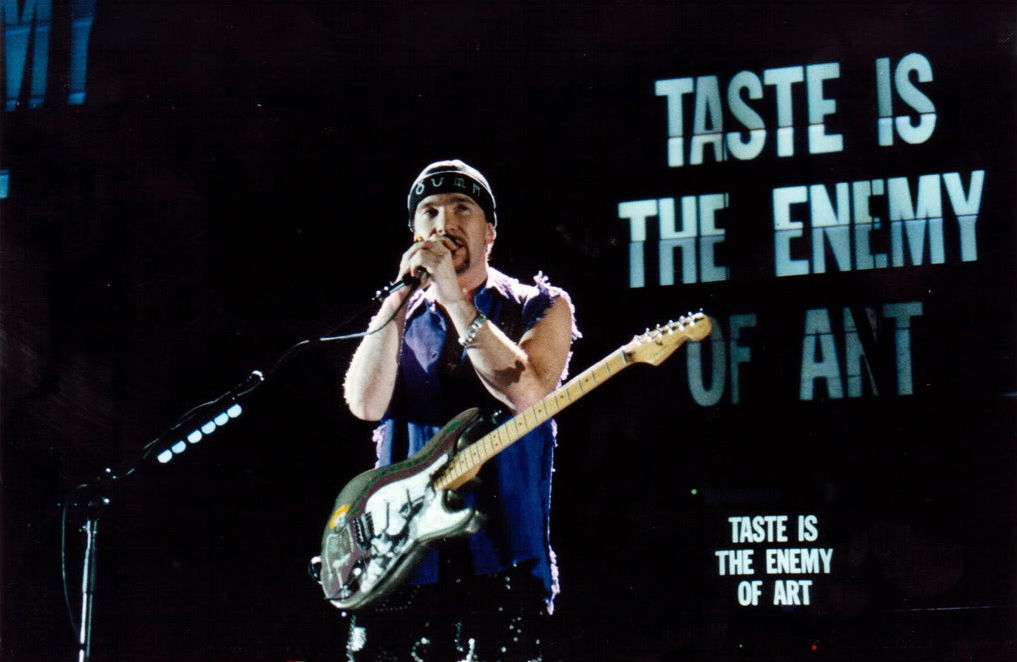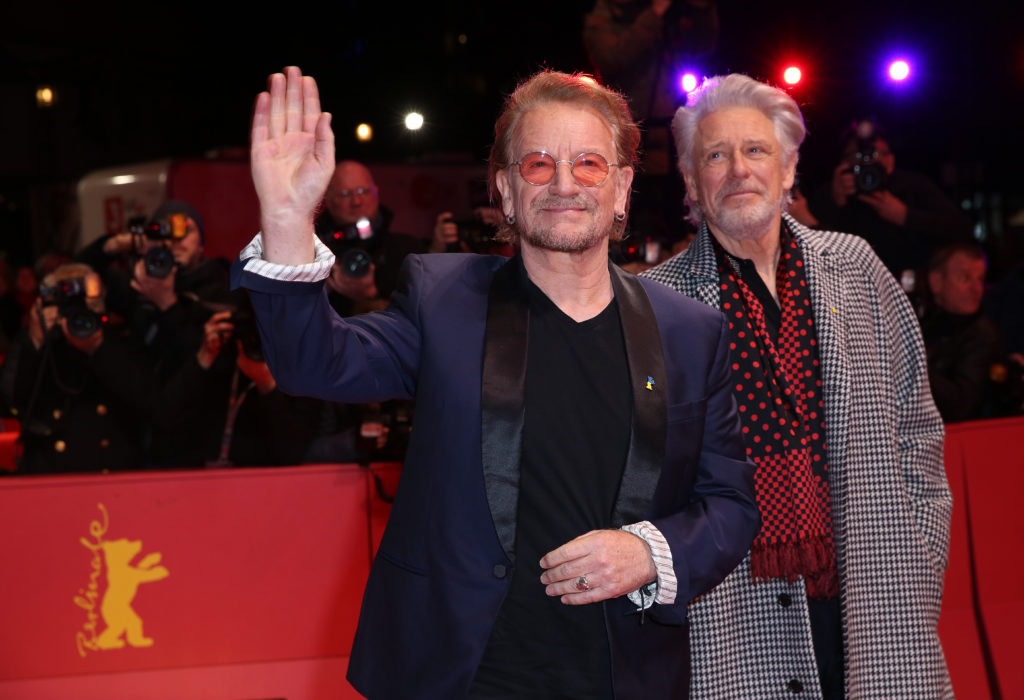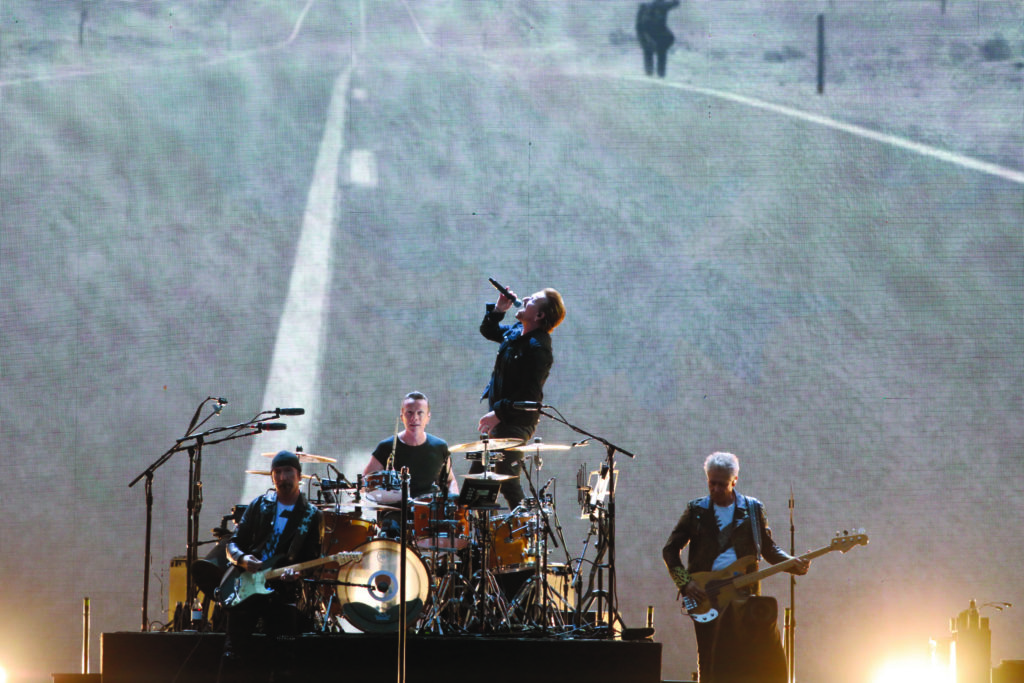TONY CLAYTON-LEA gives a retrospective on the bold artistic choices that produced the unconventional gem that is Zooropa
 ZOOROPA TOUR The Edge performing at the Melbourne Cricket Ground thirty years ago (Wikimedia Commons)
ZOOROPA TOUR The Edge performing at the Melbourne Cricket Ground thirty years ago (Wikimedia Commons)THE DECADES whizz by, of course, but if there’s anything to make you feel your age it’s when albums you really like celebrate a big ‘0’ birthday. You don’t mind the 10th (sure, that was only a few years ago), you take note of the 20th (yes, I really must start going to the gym), but the 30th is always problematic (mother of God, where on earth did the time go?).
Did we say problematic? Funny that – because that is exactly what U2 think about Zooropa, the follow-up to arguably their best album (Achtung Baby). “I thought of Zooropa at the time as a work of genius,” U2’s Bono has said. “I really thought our pop discipline was matching our experimentation and this was our Sgt Pepper… I was a little wrong about that. The truth is our pop disciplines were letting us down. We didn't create hits. We didn't quite deliver the songs.”
A bit of background: In November 1991, U2 released Achtung Baby, which the band declared was “the sound of U2 chopping down The Joshua Tree”. They were right in that the new creative direction was the polar opposite to their previous widescreen sonic vistas.
In a weird but typical U2 fashion, they were able to reconstruct and recalibrate their sound without any apparent discomfort — although when you drill down into the lyrics, you realise discomfort was never very far from the surface.
Mirroring this new artistic direction was the stage show, a new-fangled, technology-driven, spectacular audio-visual extravaganza called the Zoo TV Tour. A ground-breaking assembly of live satellite transmissions, video confessionals, a sensory overload of quickfire visuals, and a band at the very top of their game, the tour was regarded – even decades later – as perhaps the most stunning ever staged by a rock band. “Some of the ideas we started out with on Achtung Baby,” said The Edge, U2’s guitarist, “started to come into focus on the tour as we played around with the new stage set, the TV screens, the whole concept of a TV station on the road. We found out what it could do and then we started playing around with the imagery and the ideas that were in the airstream, gleaned from the world of advertising, CNN, MTV and so on.”
At the beginning of 1993, during a six month break between sections of touring – when most music acts would have taken the reasonable option and holidayed somewhere in the sun – U2 hunkered down in Dublin and started recording the follow-up to Achtung Baby. “We thought we could live a normal life and then go back on the road,” said Bono. “It turns out that your whole way of thinking, your whole body has been geared toward the madness of Zoo TV, so we decided to put the madness on a record. Everybody's head was spinning, so we thought, why not keep that momentum going?” Cue Zooropa.
Initially planned to be an EP (usually not more than five or six songs) as an accompaniment to Achtung Baby and the Zoo TV Tour, which was scheduled to recommence in May, the EP idea was jettisoned in favour of a full album. “The music that came out on Zooropa was very influenced by the tour,” noted The Edge. “Normally it’s the other way around.”
Unusually for a U2 album, the writing and recording of songs occurred at a frenetic pace. Songs were sourced from various areas of the band’s creative arsenal. Some were retrieved from the Achtung Baby recording sessions: an instrumental track that formed the basis of Numb, a verse melody that was eventually used on Stay (Faraway, So Close). Other songs were written virtually on the spot. As weeks passed, the deadline for recommencing the Zoo TV Tour approached, and when the band embarked on the next leg of shows they knew the album wasn’t close to completion.
 RETURN TO GERMANY Bono with U2 bass player Adam Clayton earlier this year in Berlin (picture by Adam Berry/Getty Images)
RETURN TO GERMANY Bono with U2 bass player Adam Clayton earlier this year in Berlin (picture by Adam Berry/Getty Images)How to resolve that? Easy – U2 flew back and forth in their private aircraft between Dublin and their European show locations for the best part of two weeks to put the finishing touches to the songs. The process, said the band’s (then) manager Paul McGuinness, almost compromised the mental health of everyone concerned. Bass player Adam Clayton said the relentless workload was “the craziest thing you could do to yourself”, while the band’s drummer (and arch pragmatist) Larry Mullen Jr, said: “It was mad, but it was mad good as opposed to mad bad.”
Of course, as is mostly the case with U2, it worked out in the end. Zooropa’s unifying music style avoided traditional rock songs in favour of what The Edge described as “disjointed, experimental pop.”
From metallic blues (Daddy’s Gonna Pay for Your Crashed Car) and futuristic European disco (Lemon) to what Bono wryly termed “the ultimate Holiday Inn band from Hell” (The Wanderer, with vocals by Johnny Cash), the album was unleashed into the world as (observed Rolling Stone) “a daring, imaginative coda to Achtung Baby.”
The Irish Independent’s then music critic (George Byrne, now deceased) had little positive to say about it: “The songs sound like they were knocked up in double-quick time and with about as much thought put into the lyrics as goes into a DJ's time check.”
Irrespective of the reception by various sections of the media, Zooropa quickly became not just a sonic add-on to the Zoo TV Tour but also (because of its mostly playful, sometimes perplexing, meandering songs) a fan favourite. To date, over seven million copies have been sold, and that isn’t counting online platform plays.
Zooropa continues to play a part in the lengthy, creative narrative of U2. Almost 300,000 fans will be hearing it from the end of September when U2 begin their concert series at the Venetian Hotel, in Las Vegas. Much like 30 years ago, technology will be the band’s best friend, but in 2023 the video screens will be bigger and better (the venue’s wraparound LED screen measures 160,000 sq ft, making it the largest in the world, while its 16K resolution makes it the world’s highest resolution). Between September 29th and December 16th, the band’s 25 shows at the MSG Sphere (a purpose-built, 18,000-plus capacity venue that is the world’s most technologically advanced) will focus on “honouring” Achtung Baby, which U2 had planned to tour in 2020 but couldn’t due to pandemic restrictions.
As an important adjunct, Zooropa will very much be in the mix – so let’s pop the corks and wish a happy 30th birthday to the album that Adam Clayton defined as “odd”, and which The Edge stated was nothing more “than an interlude.”
 CROKER CRACKER U2 perform at Croke Park on the 30th anniversary of The Joshua Tree (picture by Leah Farrell/RollingNews.ie)
CROKER CRACKER U2 perform at Croke Park on the 30th anniversary of The Joshua Tree (picture by Leah Farrell/RollingNews.ie)
